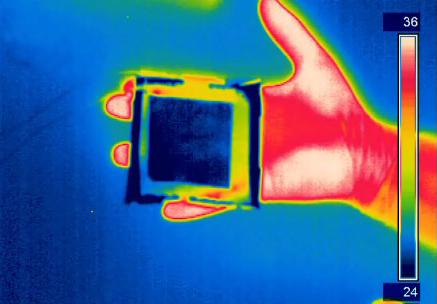Hunters or soldiers wear camouflage to blend with the surroundings and make themselves inconspicuous. Modern thermal vision, however, will make any warm-blooded animal pop up like a light bulb even in pitch-black darkness. This is where thermal-camo comes in.
After some previous failed attempts, an international team of researchers has now demonstrated one of the most promising thermal-camouflages to date. Their device made a hand’s thermal signature blend with the environment in a matter of minutes after it was switched on. It worked for both hot and cold environments.
Thermal cameras detect objects by reading the infrared radiation emitted by it. Infrared light is invisible to the naked eye but can be felt as heat if the intensity is high enough. In other words, thermal cameras more or less record the temperature of various objects in their line of sight, and then assign each temperature a shade of a color, allowing you to see how much heat its radiating compared to objects around it. Colder temperatures are typically given a shade of blue, purple, or green, while warmer temperatures can be assigned a shade of red, orange, or yellow. This is just a matter of visual representation.
In police helicopters, for instance, thermal night vision is very important since it allows officers to quickly differentiate a person from the rest of the environment. Utility and energy companies use it to see where a house might be losing heat through door and window cracks, or whether a heating system is functioning properly. Doctors sometimes use thermal vision to diagnose various disorders and diseases.
But does this mean that there’s no escaping thermal imaging?
Writing in the journal Nano Letters, Coskun Kocabas, a professor of 2D materials at the University of Manchester, UK — where graphene was also first developed — describes a new system that can relatively quickly reconfigure its thermal appearance to blend with the environment.
Previous attempts had encountered various problems such as slow response speed, lack of adaptability to different temperature regimes, and the exclusive use of rigid materials. Kocabas and colleagues have worked around all of these challenges by working with a fast, rapidly adaptable, and flexible material.
Their camouflage system is comprised of a membrane soaked with an ionic liquid sandwiched between a top electrode made of graphene and a bottom electrode from a gold coating on a heat-resistant nylon. The ionic liquid, which contains both positively and negatively charged ions, responds to a small voltage by releasing ions into the graphene, thereby reducing infrared radiation emissions from its surface.
“The demonstrated devices are light (30 g/m2), thin (<50 μm), and ultraflexible, which can conformably coat their environment. In addition, by combining active thermal surfaces with a feedback mechanism, we demonstrate realization of an adaptive thermal camouflage system which can reconfigure its thermal appearance and blend itself with the varying thermal background in a few seconds,” the authors of the new study wrote.
The whole system is thin, light, and can bend around objects, such as a person’s body parts. To demonstrate all these features, the researchers bent the system around a person’s hand, whose thermal signature then became indistinguishable from its surroundings, in both warmer and cooler environments. Besides camouflage, the new system could be used in a number of technical systems, such as adaptive heat shields for satellites.










